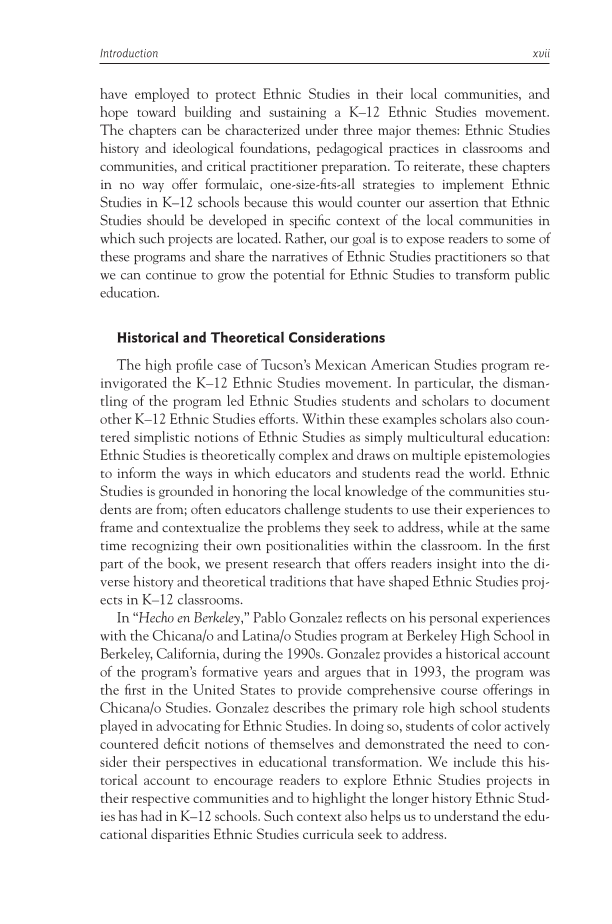Introduction xvii have employed to protect Ethnic Studies in their local communities, and hope toward building and sustaining a K–12 Ethnic Studies movement. The chapters can be characterized under three major themes: Ethnic Studies history and ideological foundations, pedagogical practices in classrooms and communities, and critical practitioner preparation. To reiterate, these chapters in no way offer formulaic, one-size-fits-all strategies to implement Ethnic Studies in K–12 schools because this would counter our assertion that Ethnic Studies should be developed in specific context of the local communities in which such projects are located. Rather, our goal is to expose readers to some of these programs and share the narratives of Ethnic Studies practitioners so that we can continue to grow the potential for Ethnic Studies to transform public education. Historical and Theoretical Considerations The high profile case of Tucson’s Mexican American Studies program re- invigorated the K–12 Ethnic Studies movement. In particular, the disman- tling of the program led Ethnic Studies students and scholars to document other K–12 Ethnic Studies efforts. Within these examples scholars also coun- tered simplistic notions of Ethnic Studies as simply multicultural education: Ethnic Studies is theoretically complex and draws on multiple epistemologies to inform the ways in which educators and students read the world. Ethnic Studies is grounded in honoring the local knowledge of the communities stu- dents are from often educators challenge students to use their experiences to frame and contextualize the problems they seek to address, while at the same time recognizing their own positionalities within the classroom. In the first part of the book, we present research that offers readers insight into the di- verse history and theoretical traditions that have shaped Ethnic Studies proj ects in K–12 classrooms. In “Hecho en Berkeley,” Pablo Gonzalez reflects on his personal experiences with the Chicana/o and Latina/o Studies program at Berkeley High School in Berkeley, California, during the 1990s. Gonzalez provides a historical account of the program’s formative years and argues that in 1993, the program was the first in the United States to provide comprehensive course offerings in Chicana/o Studies. Gonzalez describes the primary role high school students played in advocating for Ethnic Studies. In doing so, students of color actively countered deficit notions of themselves and demonstrated the need to con- sider their perspectives in educational transformation. We include this his- torical account to encourage readers to explore Ethnic Studies projects in their respective communities and to highlight the longer history Ethnic Stud- ies has had in K–12 schools. Such context also helps us to understand the edu- cational disparities Ethnic Studies curricula seek to address.
Document Details My Account Print multiple pages
Print
You have printed 0 times in the last 24 hours.
Your print count will reset on at .
You may print 0 more time(s) before then.
You may print a maximum of 0 pages at a time.




































































































































































































































































































































































































































































































































































































































































































